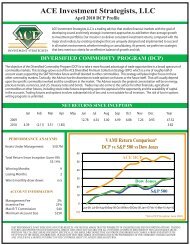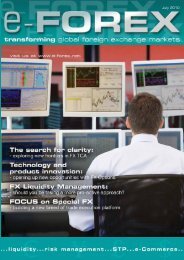You also want an ePaper? Increase the reach of your titles
YUMPU automatically turns print PDFs into web optimized ePapers that Google loves.
ALGORITHMIC FX TRADING<br />
underpinned the FX market for decades. But Hastings<br />
believes the claims that relationship banking will cease to<br />
exist is wide of the mark. “The prices in the FX market<br />
are heavily <strong>com</strong>moditised at the moment and I think<br />
those relationships still exist.” If anything, the rise of<br />
electronic and algorithmic trading could well strengthen<br />
the relationship between sell-side banks and brokers and<br />
their buy-side customers. “All e-<strong>com</strong>merce has ever done<br />
is allow the sales staff to focus on doing what they are<br />
good at, which is about talking to their customers.”<br />
David Hastings<br />
“There are still the two camps in terms of algo users – those<br />
who are using them to add alpha and those who are using<br />
them to trade more opportunistically.”<br />
Algorithmic trading has of course been around in the<br />
equities market for longer than it has been in FX and<br />
while many aspects of the algorithms are easily translated<br />
from one asset class to another, this is not the case for all<br />
of them. For example, stealth algorithms have be<strong>com</strong>e<br />
more popular in equities due to the need for traders to<br />
reduce their market impact and restrict any unhelpful<br />
price movements that may result from making their<br />
trading intentions known. Equally in demand in the<br />
equities space are algorithms for discovering hidden or<br />
dark liquidity as off-exchange liquidity and dark pools<br />
continue to thrive in the post-MiFID era.<br />
However the OTC nature of the FX market and the<br />
relatively huge levels of liquidity means that market<br />
impact and hidden liquidity are minor issues for FX<br />
traders. Nevertheless, says Hastings, these are some<br />
developments in these areas. “There has always been a<br />
fear among all traders when it <strong>com</strong>es to executing their<br />
trades and they want to keep their cards close to their<br />
80 | january 2010 e-FOREX<br />
>>><br />
chest. But it will take longer for stealth algorithms to<br />
make an impact in the FX market.” Right now it is the<br />
multi-asset trading firms that are using FX as an alphagenerating<br />
asset class that will have most interest in<br />
stealth algorithms. The algos they are currently using are<br />
more juvenile and immature and are based on simple<br />
VWAP or TWAP strategies but the more the multi-asset<br />
traders get involved in the FX market, the more<br />
sophisticated the algorithms will be<strong>com</strong>e.<br />
“We do have a stealth algorithm that is available and we<br />
are seeing some interest from FX traders but it is more<br />
interest than active adoption. I think everyone wants to<br />
wait and see how it pans out. For all of these trading<br />
strategies that have <strong>com</strong>e from the equities world, it<br />
takes some time for them to be adapted to the FX<br />
market. You cannot simply flick a switch and make<br />
equities algorithms work in the FX market. There is a lot<br />
more manipulation of the order that needs to be done.<br />
You are able to slice and dice an FX order far more than<br />
in the relative restricted equities world. The algorithms<br />
may be on the same baseline but I think there will be far<br />
more modifications and adaptations for FX algorithms.”<br />
More exotic strategies<br />
Another growing area in FX trading involves emerging<br />
currencies and alternative FX order types, such as FX<br />
options. Will FX algorithms also be able to cater for<br />
these more exotic trading strategies as well as the vanilla<br />
side of the business? “I find it hard to believe that<br />
liquidity providers will <strong>com</strong>pletely embrace the practice<br />
of streaming a price in large quantity for some of the<br />
emerging currency pairs out there. If I was trading an<br />
emerging currency pair, I wouldn’t want a price for a<br />
large amount accessable for a long period of time. The<br />
ability to manage or hedge that risk be<strong>com</strong>es more<br />
<strong>com</strong>plex because of the lack of liquidity around these<br />
currencies,” says Hastings.<br />
As for FX options, these have been a holy grail for any<br />
multi-bank offering, says Hastings. “There is a lot of<br />
dialogue and negotiation between counterparties<br />
needed for an option and streaming volatility does not<br />
answer all the idiosyncrasies associated with these<br />
instruments. I think they will be incorporated into the<br />
FX algorithms world but we are not there yet.”<br />
Many of the latest generation of algorithms have more<br />
of an emphasis on highly technical trading rather than<br />
just the fundamentals, says Joey Horowitz, chief<br />
technology officer at Aegisoft a provider of global<br />
trading solutions, software and professional services<br />
Similarly the algos have also be<strong>com</strong>e much more<br />
market aware. "As more venues have <strong>com</strong>e onto the<br />
market, it is important that the algos reflect the










